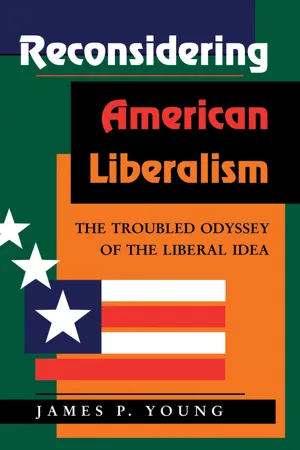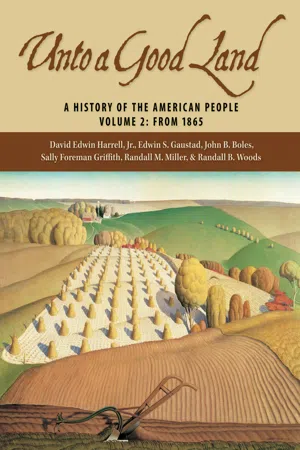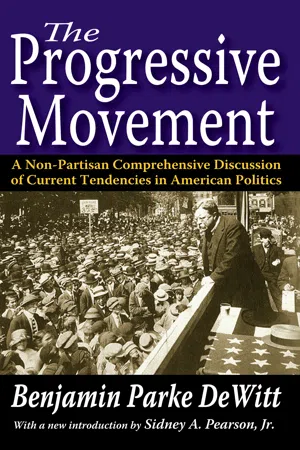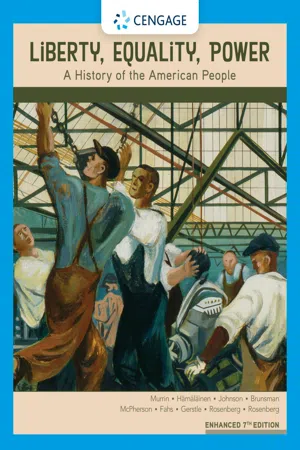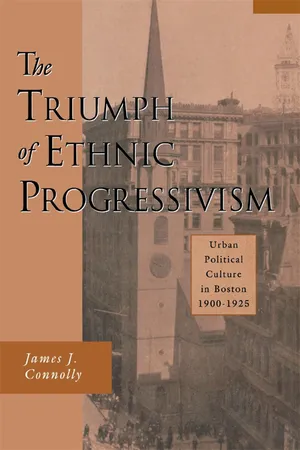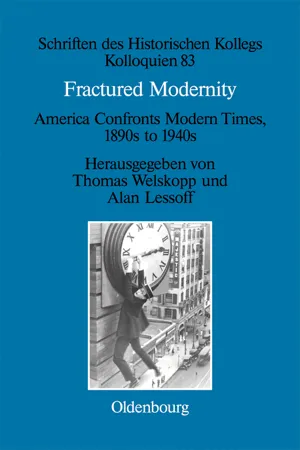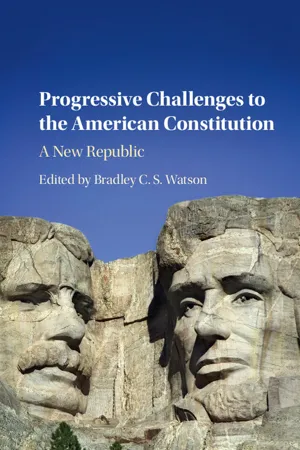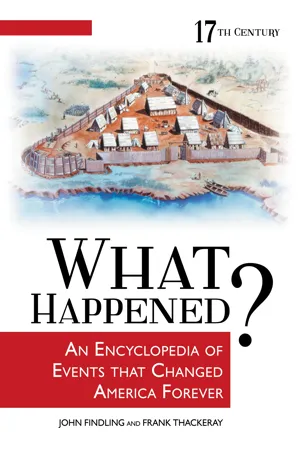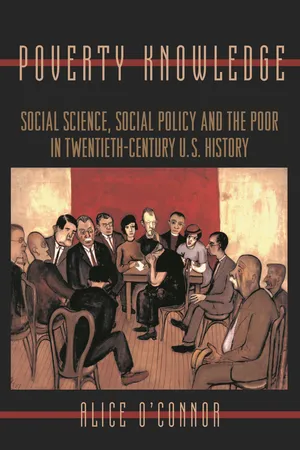History
Origins of Progressivism
The origins of progressivism in the late 19th and early 20th centuries stemmed from a desire to address social and political issues resulting from industrialization and urbanization. Progressives sought to reform government, improve working conditions, and address social inequalities through various means such as regulation, labor laws, and social welfare programs. This movement was characterized by a belief in the ability of government to enact positive change.
Written by Perlego with AI-assistance
Related key terms
1 of 5
12 Key excerpts on "Origins of Progressivism"
- eBook - ePub
Reconsidering American Liberalism
The Troubled Odyssey Of The Liberal Idea
- James Young(Author)
- 2018(Publication Date)
- Routledge(Publisher)
10 The Problem of ProgressivismTHE ORIGINS of the modern American state lie in the ideas and institutional changes of the Progressives. The state that the Progressive movement fostered, which began an attempt to make peace with modernity, produced results that can hardly have been what the populists had in mind. Nevertheless, the incipient modern state did introduce into American politics a conception of activist government, which the populists had previously championed, and it also adopted some of their institutional remedies. As with populism, the historiography of progressivism is extremely complex, so much so that some historians have proposed discarding the very term as conceptually useless.1 This solution has not taken hold, so it is necessary to try to sort out at least some of the conflicting viewpoints. Part of the difficulty no doubt lies in the fact that progressivism, unlike populism, was a national movement, which manifested itself at the federal, state, and local levels of government and which was subject to considerable ideological debate and political infighting. Moreover, there was often a gap between the fierce moral rhetoric of the movement and its actual accomplishments. Therefore, some observers have been moved, perhaps not entirely without reason, to question the motives of the reformers. One might add that the moral rhetoric of the political leaders often contrasted with the relativism of the Progressive philosophers.Progressivism, though heir to a good deal of populist rhetoric and ideology, was primarily an urban, middle-class phenomenon; it lasted for a considerable period of time—conventionally, from 1900 to 1920. However, perhaps more important than who the Progressives were and where they were located was the fact that they, unlike the populists, produced a great deal of social and political theory. Further, to a great extent, those ideas continue to be of great importance in shaping contemporary liberal thought. To some extent, reform liberals today might be said to be living still on the intellectual capital of progressivism. - eBook - ePub
Unto a Good Land
A History of the American People, Volume 2: From 1865
- David Edwin Harrell, Edwin S. Gaustad, John B. Boles, Sally Foreman Griffith(Authors)
- 2005(Publication Date)
- Eerdmans(Publisher)
24
Progressivism in American Politics, 1901 to World War I
Chapter 24 at a Glance The Core of the Progressive Agenda The Urban Social Justice Movement Saving the WASP Empire Local and State Political Reform Reorganizing American Cities Progressivism in the States Electoral Reform—Democratic and Undemocratic States Provide Models for Progressive Legislation Theodore Roosevelt and the Selling of National Progressivism Theodore Roosevelt Takes Center Stage The Extension of Regulation and Trustbusting Political Victory and the Square Deal A Beginning for Conservation Roosevelt Drifts to the Left Competing Progressive Visions Roosevelt Picks His Successor Taft Alienates the Progressives The Rift between Roosevelt and Taft The Election of 1912 Wilsonian Progressivism The Scholar President Congress Backs the President Expanding the New Freedom Conclusion: The Legacy of Political ProgressivismT HE ANXIETIES CAUSED by rapid social and economic change at the turn of the century defined the Progressive Era as a time of causes and crusades. The reform sentiment of the period took on added significance because most progressives looked to government to restore the American dream, and they relished political combat. The governmental reforms of the Gilded Age, including civil service reform and the growing professionalization of the Washington bureaucracy, had set the stage for the progressive movement, and the election of 1896 had provided an agenda for the progressive presidents of the early twentieth century—Theodore Roosevelt, William Howard Taft, and Woodrow Wilson. Progressives backed a broad array of social, economic, and political reforms; no one person was likely to embrace all of them. The federal government enacted the era’s most far-reaching legislation, but progressives won their first political successes at the local and state levels.Nationally, the Progressive Era witnessed a renaissance of presidential leadership, conspicuously lacking in the Gilded Age. Roosevelt and Wilson are generally ranked among the nation’s greatest chief executives, and Taft was a competent (if politically clumsy) and somewhat underrated president. Surrounding these presidents were a colorful and vigorous cast of political characters whose thought and actions helped shape modern America. - eBook - PDF
- Paul Boyer, Clifford Clark, Karen Halttunen, Joseph Kett(Authors)
- 2017(Publication Date)
- Cengage Learning EMEA(Publisher)
Women’s clubs embraced reform. Intellectuals challenged the ideological foundations of a business-dominated social order, and journalists exposed municipal corruption and industrialism’s human toll. Throughout America, activists worked to make government more democratic, improve conditions in cities and factories, and curb corporate power. Historians have grouped all these efforts under a single label: “the progressive movement.” In fact, “progressivism” was less a single movement than a spirit of discontent with the status quo and an exciting sense of new social possibilities. International in scope, this spirit found many outlets and addressed many issues. 21-1.1 The Many Faces of Progressivism Who were the progressives, and what reforms did they pursue? The social changes of the era pro-vide clues to the answers. Along with immigration, a growing middle class transformed U.S. cities. From the men and women of this class—mostly white, native-born Protestants—came many of the progressive movement’s leaders and supporters. From 1900 to 1920, the white-collar workforce jumped from 5.1 million to 10.5 million—more than double the growth rate of the labor force as a whole. This burgeoning white-collar class included corporate executives and small-business owners; secretaries, accountants, and sales clerks; civil engi-neers and people in advertising; and professionals such as lawyers, physicians, and teachers. New pro-fessional groups arose, from the American Associa-tion of University Professors (1915) to the American Association of Advertising Agencies (1917). For many middle-class Americans, membership in a national professional society provided a sense of identity that might earlier have come from neigh-borhood, church, or political party. Ambitious, well educated, and valuing social stability, the members of this new middle class were eager to make their influence felt. For middle-class women, the city offered both opportunities and frustrations. - eBook - ePub
The Progressive Movement
A Non-Partisan Comprehensive Discussion of Current Tendencies in American Politics
- Benjamin Parke DeWitt(Author)
- 2017(Publication Date)
- Routledge(Publisher)
PART I THE ORIGIN AND DEVELOPMENT OF THE PROGRESSIVE MOVEMENTPassage contains an image
CHAPTER IThe Meaning and History of the Progressive MovementTHE term “progressive movement” has been so widely used, so much discussed, and so differently interpreted that any exposition of its meaning and principles, to be adequate, must be prefaced by careful definition. To some—comparatively few—the progressive movement stands for the attempt of one man, disappointed in his efforts to control his political party, to found another and return himself to power. To others, who are willing to concede that the movement is not confined to a single leader, it represents the efforts of a small body of self-seeking politicians to gain position and influence by making capital of a movement that is temporarily popular. To others, the movement expresses the effort of a few sincere but misguided enthusiasts to carry out an impossible and chimerical program of social reform through government and legislation. Some believe that the movement is partisan, limited to the party that bears its name; others believe that it is broader than any single party and that its supporters are found in political parties everywhere. Some believe it is new, fleeting, and evanescent, destined to disappear quickly from our political life; others hold that it is permanent, deep-seated, and fundamental, involving a modification and readjustment of our political theories and institutions.Whatever difference of opinion may exist concerning the meaning of the progressive movement, every thinking man and woman must be convinced that the nation to-day is passing through a severe political crisis. After a period of unprecedented industrial and commercial expansion, during which time little or no attention has been given to the problems of government, the people have suddenly realized that government is not functioning properly and that radical changes are needed. Manifestations of this excitement and unrest are seen on every hand. Men write of a new democracy1 and a new freedom.2 - eBook - PDF
Liberty, Equality, Power
A History of the American People, Enhanced
- John Murrin, Pekka Hämäläinen, Paul Johnson, Denver Brunsman(Authors)
- 2019(Publication Date)
- Cengage Learning EMEA(Publisher)
Two presidents, Theodore Roosevelt and Woodrow Wilson, placed themselves at the head of this movement. Progressivism was popular among a variety of groups who brought to the movement distinct, and often conflicting, aims. On one issue, however, most progressives agreed: the need for an activist government to right political, economic, and social wrongs. Some progressives wanted government to become active only long enough to clean up the political process, root out vice, upgrade the electorate, and break up monopolies. These problems were so difficult to solve that many other progressives endorsed the notion of a permanently active government—with the Library of Congress Prints and Photographs Division [LC-DIG-ppmsca-27931] 574 CHAPTER 21 Progressivism, 1900–1917 power to tax income, regulate industry, protect consumers from fraud, empower workers, safeguard the environment, and provide social welfare. Many progressives, in other words, came to see the federal government as the institution best equipped to solve social problems. Such positive attitudes toward government power marked an important change in American politics. Americans had long been suspicious of centralized government, viewing it as the enemy of liberty. The Populists had broken with that view (see Chapter 19), but they had been defeated. The progressives had to build a new case for strong government as the protector of liberty and equality. ■ 21-1b Muckrakers Many disaffected Protestants found a focus for their alienation in the work of investigative journalists known as muckrakers , so-called because of their determination to dredge up the “muck” saturating important institutions of American life. Ida Tarbell revealed the shady practices by which John D. Rockefeller had transformed his Standard Oil Company into a monopoly. Lincoln Steffens unraveled the webs of bribery and corruption that were strangling local governments in the nation’s cities. - eBook - PDF
Popular Controversies in World History
Investigating History's Intriguing Questions [4 volumes]
- Steven L. Danver(Author)
- 2010(Publication Date)
- ABC-CLIO(Publisher)
The Republican Roosevelt. New York: Atheneum, 1974. Chandler, Alfred D. ‘‘The Origins of Progressive Leadership,’’ The Letters of Theodore Roosevelt, Vol. VIII. Edited by Elting Morison. New York: Univer- sity of Cambridge Press, 1958. Crunden, Robert M. Ministers of Reform: The Progressives’ Achievement in American Civilization, 1889–1920. New York: Basic Books, 1982. de Tocqueville, Alexis. Democracy in America. London: Saunders and Otley, 1835. Ely, Richard T. Studies in the Evolution of Industrial Society. New York: Macmillan, 1903. Hofstadter, Richard. The Age of Reform: From Bryan to F.D.R. New York: Random House, 1955. Hofstadter, Richard. ‘‘Do We Find the Roots of Progressivism in the Cities or on the Farms?’’ In Who Were the Progressives? Edited by Glenda Elizabeth Gilmore. New York: Bedford/St. Martins, 2002. Kolko, Gabriel. The Triumph of Conservatism: A Reinterpretation of American History, 1900–1916. New York: Free Press, 1963. McClay, Wilfred M. ‘‘Croly’s Progressive America.’’ Public Interest (Fall 1999): 56–72. McGerr, Michael. A Fierce Discontent: The Progressive Movement in America. New York: Free Press, 2005. Riis, Jacob A. The Peril and Preservation of the Home: The William L. Bull Lectures. Philadelphia: George W. Jacobs & Co., 1903. Smythe, William E. Constructive Democracy: The Economics of a Square Deal. New York: Macmillan, 1905. Wiebe, Robert H. The Search for Order: 1877–1920. New York: Hill and Wang, 1967. Wrobel, David M. The End of American Exceptionalism: Frontier Anxiety from the Old West to the New Deal. Lawrence: University Press of Kansas, 1993. CON With the end of the Civil War and the Gilded Age, the United States entered the modern Industrial Revolution. This period centered on a collectivism that began in 1870 and closed with the American entry into the Great War, World War I, CON | 15 when America turned to individualism. This collapse was partly the result of the success of the movements of various and dispersant groups. - eBook - PDF
The Triumph of Ethnic Progressivism
Urban Political Culture in Boston, 1900–1925
- James J. Connolly, James J. CONNOLLY(Authors)
- 2009(Publication Date)
- Harvard University Press(Publisher)
They mobilized their supporters in both ethnic and Progressive terms simultaneously. In doing so, they helped give specific meaning to the ethnic experience in Boston and throughout the United States. 25 Recent scholarship demonstrating the specifically ethnic and racial dimensions of early-twentieth-century reform lends credence to this interpretation. African-American men and women adopted the Pro-gressive style of political action to achieve their own particular goals. Mexican immigrants in California appropriated “new nationalism” and other elements of Progressive reform as part of the effort to create a distinctive Mexican-American identity. Even in bastions of Progres-sive reform such as Wisconsin, factions within the LaFollette coalition pursued specifically ethnic agendas. The significance of these efforts stems less from their immediate success or failure at the ballot box or in legislative chambers than from the role they played in defining and mobilizing groups during the early twentieth century. 26 Approached in this fashion, Progressivism’s fate in the 1920s must be recalibrated. Historians have generally imagined the twenties as a period of reaction against the apparent reform consensus of the pre– World War I era. Yet the period after the war can also be seen as a continuation of patterns set in motion before the war rather than a sharp break from them. As men and women desiring to speak for ethnic groups and neighborhoods seized on Progressivism as a tool to define and politicize collective identities, cultural clashes sharpened. For a time the coalitions that formed behind specific reform measures masked these differences, but as the differing interpretations and ex-pectations each group attached to these proposals became evident, tensions increased. It is important to remember that this process began during the Pro-gressive Era itself, rather than with World War I. - eBook - PDF
- Jane Kamensky, Carol Sheriff, David W. Blight, Howard Chudacoff(Authors)
- 2018(Publication Date)
- Cengage Learning EMEA(Publisher)
The nation emerged victorious from a war against Spain (see Chapter 19), and an era of new political leaders, includ- ing a new brand of president, was dawning. A sense of renewal served both to intensify anxiety over continuing problems and to raise hopes that somehow those problems could be fixed so that democracy could be reconciled with capitalism. From these circumstances emerged a complex and many-sided reform campaign. By the 1910s, reformers of various sorts were calling themselves Progressives; in 1912, they formed a political party by that name to embody their principles. Historians have uniformly used the term Progressivism to refer to the era’s spirit, while disagreeing over its meaning and over who actually was a Progressive. Nonetheless, the era between 1895 and 1920 included a series of movements, each aiming in one way or another to renovate or restore American society, values, and institu- tions with hope that a better future lay ahead. The reform impulse had many sources. Industrial capi- talism had created awesome technology, unprecedented pro- ductivity, and a cornucopia of consumer goods. But it also brought harmful overproduction, domineering monopolies, labor strife, and destruction of natural resources. Burgeoning cities facilitated the amassing and distribution of goods, ser- vices, and cultural amenities; they also bred poverty, disease, and crime. The influx of immigrants and rise of a new class Experience an interactive version of this story in MindTap ® . Copyright 2019 Cengage Learning. All Rights Reserved. May not be copied, scanned, or duplicated, in whole or in part. Due to electronic rights, some third party content may be suppressed from the eBook and/or eChapter(s). Editorial review has deemed that any suppressed content does not materially affect the overall learning experience. Cengage Learning reserves the right to remove additional content at any time if subsequent rights restrictions require it. - eBook - PDF
Fractured Modernity
America Confronts Modern Times, 1890s to 1940s
- Thomas Welskopp, Alan Lessoff, Thomas Welskopp, Alan Lessoff(Authors)
- 2016(Publication Date)
- De Gruyter Oldenbourg(Publisher)
Alternative lines in progressive thought, however, inspired the National Association for the Ad-vancement of Colored People, the Urban League, and other civil rights organiz-ations founded in the period. Women activists and women’s issues, as noted ear-lier, played an indispensible role in progressive action and thought. Still, historians of the race and gender dimensions of progressivism are often less animated by the analytical implications of their work than by its usefulness to present-day move-ments to spur pride among African Americans and women, overcome inequities based on race and gender, and press the country to live up to its egalitarian ideals. In this sense, this writing is new version of the so-called New History or progres-sive history promoted in the Progressive Era by James Harvey Robinson and Charles Beard, who emphasized reinterpretation of the past in service of contem-porary issues and agendas. To cite another example, much domestic American discussion of the Progres-sive Era centers on dramatic political personalities who symbolize aspects of the era and stances on its problems. American writing on these pivotal figures can have an internal-conversation quality whose assumptions are hard to penetrate. Theodore Roosevelt, the public figure most identified with American progressiv-ism, should be recognizable to Europeans, even given his belligerent chauvinism and his romantic embrace of the West and frontier lore. TR’s fusion of a national-ist foreign policy with a nationalistic domestic reform agenda – along with his pa-trician sense of social responsibility and his imaginative engagement with the economic, social, and cultural implications of modernity – had many counterparts across Europe. Contemporaries contrasted and historians still contrast Roosevelt with his main rival among Republican progressives, Robert La Follette, who perceived a big-city, Tory element in Roosevelt out of sympathy with the country’s heartland democracy. - eBook - PDF
Progressive Challenges to the American Constitution
A New Republic
- Bradley C. S. Watson(Author)
- 2017(Publication Date)
- Cambridge University Press(Publisher)
It is offered as one concise example of how progres- sivism and the Social Gospel were deeply connected at the levels of both ideas and policy. 41 For both the Social Gospel and progressivism gener- ally, the evolutionary power of history had brought a sea change in what was possible both in human nature and in human government. The power of the state came to be looked on with new optimism, a vision that required the overturning of both the old theology and the old political philosophy. notes 1. This was particularly true of those associated with the New Republic and the more scientific wing of the movement. But even this element of the movement shared the view of its more religiously inclined progressive brethren: that the orthodox variant of Christianity was a great obstacle to progress and that it was especially an obstacle to reforming education. Progressives saw in tradi- tional religious education an unhealthy encouragement of the young to focus on the private sphere, thus detracting from the undivided devotion to the state on which progressive democracy was to depend. The New Republic 156 American Progressivism and the Social Gospel editorialized in 1916 that there should be a “change in the meaning of tolerance.” Contrary to eighteenth-century liberalism, the editors explained, “twentieth-century democracy believes that the community has certain posi- tive ends to achieve, and if they are to be achieved the community must control the education of the young.” It editorialized that “freedom and tolerance mean the development of independent powers of judgment in the young, not the freedom of older people to impose their dogmas on the young.” Modern democracy, it concluded, “insists that the plasticity of the child shall not be artificially and prematurely hardened into a philosophy of life.” “Father Blakely States the Issue,” unsigned editorial from the New Republic, July 29, 1916, 320. - eBook - PDF
- John E. Findling, Frank W. Thackeray, John E. Findling, Frank W. Thackeray(Authors)
- 2010(Publication Date)
- ABC-CLIO(Publisher)
After the end of the Progressive era, concern over pollu- tion in the cities and maintenance of public lands fell dormant until the population and technological pressures of the s transformed the latent Progressive conservation- ism into modern environmentalism. If progressivism degenerated into a confused morass of half-starts and nativism at the federal level, the grass-roots origins of the movement remained alive. Local wom- en’s clubs continued to fight for sanitation and education. State-appointed factory inspectors relentlessly gathered statistics on child labor and hazardous working condi- tions. African Americans painstakingly brought suit in court for equal access to the re- sources of American society. Individual chapters of wilderness clubs readily heard and supported the new professional ecologists. The Progressive era ended with World War I, but reform efforts continued. The experiments in governmental activism left a legacy of official willingness to regulate social interactions. Self-confident, educated, financially independent, and spiritually driven, the Pro- gressives breached the traditional wall between the public and private sectors. Though unable to take full advantage themselves of the new responsiveness of government, the young middle-class adults of turn-of-the-th-century America opened a path that later generations were to pave. SELECTED BIBLIOGRAPHY Boyer, Paul. Urban Masses and Moral Order in America, –. Cambridge: Cambridge University Press, . Chronicles attempts to instill traditional rural moral values into the people of the new urban centers. Bryan, Mary Lynn McCree, and Allen F. Davis, eds. One Hundred Years at Hull House. Bloom- ington: Indiana University Press, . Essays celebrating the centennial of the first and most noteworthy settlement house. Buenker, John D. Urban Liberalism and Progressive Reform. - eBook - ePub
Poverty Knowledge
Social Science, Social Policy, and the Poor in Twentieth-Century U.S. History
- Alice O'Connor(Author)
- 2009(Publication Date)
- Princeton University Press(Publisher)
CHAPTER 1Origins: Poverty and Social Science in The Era of Progressive ReformAT THE END of the nineteenth century social investigators in several of the world’s most advanced industrial societies set out to bring new scientific understanding to the problem of poverty. In this they were very much caught up in the international wave of organizing, policy innovation, state building, and, above all, social learning that characterized the decades between 1880 and the beginning of World War I as an era of progressive reform.1 They were also moved by the central paradox Henry George referred to in the title of his wildly popular Progress and Poverty (1879) and in subsequent lecture tours: that great wealth and unprecedented productive capacity brought increasing poverty. So, too, were they dedicated to challenging the precepts of “laissezfaire,” a doctrine they associated with unbridled free market capitalism, the narrow pursuit of individual self-interest, and the rise of a social scientific justification for inequality and concentrated wealth.2 Drawing on a combination of classical economics and Social Darwinism, Yale University sociologist William Graham Sumner had argued that inequality was a social expression of the natural laws of economic competition—the survival and dominance of the fittest—and that any attempt to intervene in the free market system would simply set progress back on its heels.3 Poverty was not only inevitable but, in Sumner’s words, “the best policy”: deprived by their own or by nature’s doing, the poor had no special claim on society at large.The new knowledge, in contrast, would distinguish itself from other types of “scientific” investigation in several ways, which together make the Progressive Era a foundational period for twentieth-century poverty research. In the first instance it would be rigorously empirical—for the most part, quantitative—distinguishing it from the more abstract discourse of classical economics that inscribed poverty, along with the operation of markets, with the aura of natural law. The new poverty knowledge would take its cue instead from the insurgent, German-influenced “new economics” expounded by Richard T. Ely, Henry Carter Adams, and other founders of the American Economic Association in 1885, which embraced a more historical and institutional, but above all, social and ethical understanding of how the capitalist economy had evolved.4 Second, the new poverty knowledge would be rigorously objective, as distinct from the morally judgmental inquiries of charity work, and would devote itself to devising more and ever-better scientific methods for gathering, categorizing, and analyzing the facts of social, as opposed to merely individual, circumstance. Third, the new poverty knowledge would in no other sense be neutral; it would, without bias toward specifics, serve the interests of reform. Moreover, the new knowledge would be instrumental in other ways as well, serving the institution-building objectives of a burgeoning array of public and private organizations—social settlements, philanthropies, professional and civic groups, state and federal bureaus of research—that were beginning to look beyond the patchwork of local poor laws and private charities for ways of prevention rather than relief.5 The first order of business for the new poverty knowledge, then, was not only to denaturalize but to depauperize the “poverty problem,” by redirecting attention from individual dependency to social and, especially, to labor conditions as underlying cause.6
Index pages curate the most relevant extracts from our library of academic textbooks. They’ve been created using an in-house natural language model (NLM), each adding context and meaning to key research topics.
